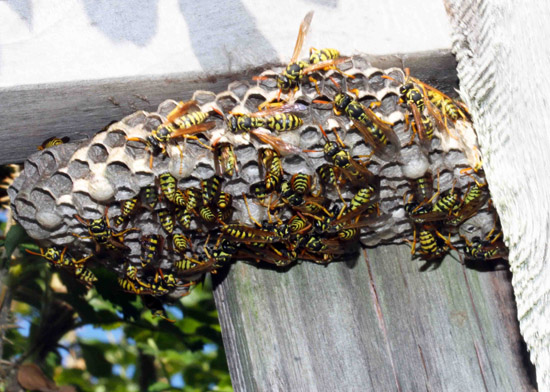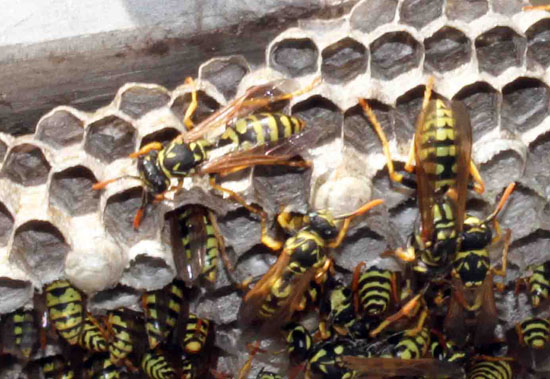Issue 15, August 27, 2012
European Paper Wasp
European paper wasp, Polistes diminula, has been identified in Urbana in central Illinois. This wasp has been in northern Illinois for several years. In North America, it is found in southern Canada and the northern U.S., being common in Ontario, Michigan, Ohio, and Wisconsin. It has not been found south of southern Virginia. In the eastern hemisphere, it is native to southern Europe and Asia and northern Africa. It will surely continue to spread farther south in the U.S.
This wasp builds umbrella-shaped nests like other paper wasps in the same genus. Like other Polistes wasps, the larvae are fed mostly caterpillars that the adults collect and chew into baby food to regurgitate to the larvae. Like other paper wasps, they will attack and repeatedly sting intruders.

European paper wasp nest with males and females.
Polistes diminula not only builds its nests under eaves and in twiggy shrubs as do other native paper wasps in the genus, but it also builds nests in confined spaces such as the piping in swing sets and clotheslines, tree hollows, attics, and junction boxes used in electrical and irrigation systems. It is also more aggressive in finding caterpillars, with areas containing large numbers having almost no butterflies due to caterpillar predation. Unlike other Polistes, it also feeds on other insects besides caterpillars. Nests are started earlier in the spring and the life cycle from egg to adult is quicker. This results in larger nests containing more wasps than native species.

Close-up of European paper wasp nest.
Eliminate paper wasps nests by spraying the underside of the nest with an aerosol wasp and hornet spray. These typically contain pyrethroids, but some contain essential oils such as mint oil or rely on freezing the insects with the propellant. Fire departments commonly use foam generators used to extinguish fires to cover and suffocate the wasps.
Spray in the evening when all of the adult wasps are on the nest, but early enough to not need a flashlight. Disturbed wasps fly at lights. Stand off to the side when spraying a nest, as falling, dying wasps can still sting. Knock down and destroy the nest the next day, although any remaining larvae will starve without the attending adults. Usually, larvae unguarded by the adults do not live long enough to starve as other wasps will find them and feed them to their own larvae. (Phil Nixon)
Author:
Phil Nixon